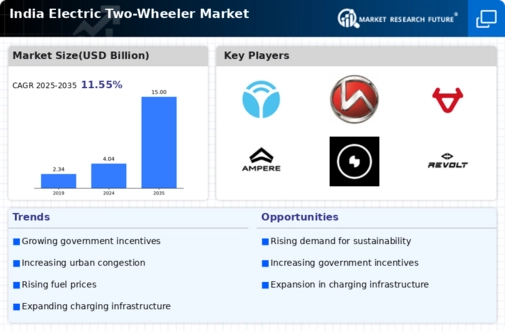Rising Fuel Prices
The escalating prices of conventional fuels have emerged as a pivotal driver for the electric two-wheeler market. As petrol and diesel prices continue to rise, consumers are increasingly seeking cost-effective alternatives. The average price of petrol in India has surged to approximately Rs 100 per liter, prompting a shift towards electric vehicles. This transition is not merely a trend but a necessity for many, as electric two-wheelers offer lower operational costs. With the cost of electricity being significantly lower than fossil fuels, the potential savings on fuel expenses can be substantial. This economic rationale is likely to drive more consumers towards adopting electric two-wheelers, thereby bolstering the market's growth. The electric two-wheeler market is thus positioned to benefit from this shift in consumer behavior, as financial considerations become paramount.
Environmental Awareness
Growing environmental consciousness among consumers is significantly influencing the electric two-wheeler market. As awareness of climate change and air pollution rises, individuals are increasingly inclined to adopt eco-friendly transportation options. The Indian government has reported alarming levels of air pollution in major cities, with particulate matter levels often exceeding safe limits. This has led to a societal push for sustainable practices, including the use of electric vehicles. The electric two-wheeler market is seen as a viable solution to reduce carbon footprints and improve urban air quality. Furthermore, the government's initiatives to promote electric mobility align with this trend, creating a conducive environment for market growth. As consumers become more environmentally conscious, the demand for electric two-wheelers is expected to rise, further propelling the market forward.
Technological Innovations
Technological advancements in battery technology and electric drivetrains are playing a crucial role in shaping the electric two-wheeler market. Innovations such as lithium-ion batteries have enhanced the efficiency and range of electric two-wheelers, making them more appealing to consumers. The average range of electric two-wheelers has improved to around 100-150 km on a single charge, addressing one of the primary concerns of potential buyers. Additionally, the integration of smart technologies, such as regenerative braking and connected features, is enhancing the overall user experience. These advancements not only improve performance but also contribute to the safety and reliability of electric two-wheelers. As manufacturers continue to invest in research and development, the electric two-wheeler market is likely to witness a surge in innovative products, attracting a broader customer base.
Government Policies and Support
Supportive government policies are a significant driver for the electric two-wheeler market. The Indian government has implemented various initiatives aimed at promoting electric mobility, including subsidies and incentives for manufacturers and consumers. Programs such as the Faster Adoption and Manufacturing of Hybrid and Electric Vehicles (FAME) scheme provide financial assistance to buyers, making electric two-wheelers more affordable. Additionally, state governments are also introducing their own incentives, further enhancing the attractiveness of electric vehicles. These policies not only lower the initial purchase cost but also encourage manufacturers to invest in electric two-wheeler production. As a result, the electric two-wheeler market is likely to experience accelerated growth, driven by favorable regulatory frameworks and financial incentives.
Urbanization and Traffic Congestion
The rapid urbanization in India is contributing to the growth of the electric two-wheeler market. With increasing population density in urban areas, traffic congestion has become a pressing issue. Electric two-wheelers offer a practical solution to navigate through crowded streets, providing a convenient and efficient mode of transportation. The compact size and maneuverability of electric two-wheelers make them ideal for urban commuting. Moreover, as cities expand, the demand for sustainable transportation options is likely to rise. The electric two-wheeler market stands to benefit from this trend, as more individuals seek alternatives to traditional vehicles that contribute to traffic woes. The combination of urbanization and the need for efficient transport solutions positions the electric two-wheeler market for substantial growth in the coming years.






















Leave a Comment